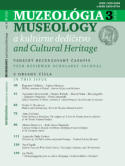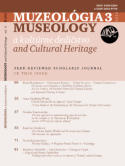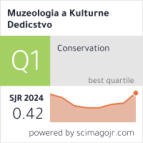

MUZEOLÓGIA
MUSEOLOGY
a kultúrne dedičstvo
and Cultural Heritage

News
Journal Muzeológia a
kultúrne dedičstvo -
Museology and Cultural
Heritage:
SJR 2024: 0,424 (Q1)
Museology SJR rank: 8/83 (Q1) Conservation SJR rank: 11/103 (Q1)JIF WoS 2023: 0,6
JCI WoS 2023: 1,28, Q1 ESCI: 49/411 (Q1)New issue
Muzeológia a kultúrne
dedičstvo 1/2025
online New volume Studia Museologica Slovaca, vol. 8 (2024) online New volume Populačné štúdie Slovenska 17 (2024) onlineNew book
P. Tišliar (ed.). Osobnosti uměleckoprůmyslového muzejnictví (2025). online
Contents 3/2023
Title: The Syntax and Semantics of Modelling Exhibition Spaces: A Case Study of the Hryhorii
Skovoroda National Literary and Memorial Museum, Ukraine
Abstract: The aim of this article is to analyse the exhibition semantics of the exposition of the H.S. Skovoroda National Literary and
Memorial Museum (Ukraine, Kharkiv region). The authors substantiate the concept of dearchaisation of Skovoroda’s image by means
of modelling the syntax and semantics of the exhibition space. According to the authors, exhibition design cannot ignore symbolism,
as the principles of cultural consumption of “places of memory” function in the stream of consumption of a work of art. The viewer does
not come for the subject, but for emotions and experience. Therefore, design should go beyond the physical properties of objects,
subjects, compositions, and so on, and the content of any design should ultimately be the conditions for gaining new experience. The
relationship between the material (object) and the imaginary (interpretation) is projected at the intersection of exhibition syntax and
semantic modelling.
Author: Bondarenko, Iryna; Tarasov, Volodymyr; Severyn, Viktor; Yermakova, Tetiana
Publication order reference: Faculty of Environment Design, Kharkiv State Academy of Design and Arts, Ukraine, e-mail:
bondirra@gmail.com, https://orcid.org/0000-0002-3471-4162; Department of Social and Humanitarian Disciplines, Kharkiv State
Academy of Design and Arts, Ukraine, e-mail: Tarasovvv1977@ gmail.com, https://orcid.org/0000-0003-2164-9135; Faculty of
Environment Design, Kharkiv State Academy of Design and Arts, Ukraine, e-mail: viktorseverin21@gmail.com, https://orcid.org/0000-
0003-0049-0815; Department of Pedagogy, Ukrainian and Foreign Philology, Kharkiv State Academy of Design and Arts, Ukraine, e-
mail: yermakova2015@gmail.com, https://orcid.org/0000-0002-3081-0229
Source: Muzeológia a kultúrne dedičstvo, year: 2023, vol.: 11, number: 3, pages: 5-22.
Key words: museum, design, museum exhibition, semiosis, representation and signification
Language: English
online full-text PDF
DOI: 10.46284/mkd.2023.11.3.1
Title: Can the Museum Be an Agent of Social Change? A New Model of the Functioning of the
Museum in the Twenty-First Century
Abstract: A large group of scholars believe that, in the face of an increasing awareness of global challenges, the mission, role, values
and responsibilities of museums as institutions require radical rethinking and transformation. In 2016, at an ICOM conference, Mário
Moutinho suggested that the category of new museology be broadened towards sociomuseology as a school of thought, whose task is
to integrate efforts to adapt museum structures to the present-day reality, to achieve a new level of autonomy for museums, and to
open museums to the social context. The philosophical basis for this movement is the idea of participation, and its goal is to create a
network of institutions, communities and individuals whose objective is sustainable local development. This approach to museum
activism means modifying the tasks the museum undertakes as a civic institution, and the new model of its operation is aimed at real
political, social and environmental change. The concept has met with criticism from researchers and museologists who believe that the
museum should preserve its identity and focus on its traditional tasks. By giving examples of similar activity conducted by some Polish
historical museums the author offers answers to the question of whether and to what extent museums in the twenty-first century can
and should adopt this new model in order to truly influence their environment while, at the same time, preserving the functions of an
institution whose role is to protect national heritage.
Authors: Ziębińska-Witek, Anna
Publication order reference: Maria Curie-Skłodowska University, Lublin, Poland, e-mail: anna.ziebinska-witek@mail.umcs.pl,
https://orcid.org/0000-0003-2682-748X
Source: Muzeológia a kultúrne dedičstvo, year: 2023, vol.: 11, number: 3, pages: 23-35.
Keywords: museum activism, participation, social change, historical museums
Language: English
online full-text PDF
DOI: 10.46284/mkd.2023.11.3.2
Title: The new approach to commemorating open-air war sites on the example of the Museum of
Westerplatte and the 1939 war in Gdańsk, Poland
Abstract: This paper focuses on current issues in the development of open-air memorial sites. The concept of open-air museums is
evolving in the twenty-first century to encompass sustainable protection of war monuments in their historical context. The cultural
landscapes require minimal intervention. However, to ensure the viability of the museums and accessibility to visitors, new additions –
in terms of architecture and urban design – are inevitable. The challenge is to guarantee the quality and coherence of any additions
and to preserve historic landscapes. It is also crucial to ensure public acceptance of revitalization efforts. Open architectural
competition might be a reliable means of delivering viable results, as demonstrated by the recent construction of a new military
cemetery and restoration of the battlefield in Westerplatte in Gdańsk, Poland.
Author: Trojanowska, Monika
Publication order reference: University of Gdańsk, Faculty of Social Sciences, Department of Spatial Studies, Gdańsk, Poland, e-
mail: monika.trojanowska@ug.edu.pl, https://orcid.org/0000-0001-8168-0746
Source: Muzeológia a kultúrne dedičstvo, year: 2023, vol.: 11, number: 3, pages: 37-51.
Keywords: open-air museums, battlefields, architecture, Westerplatte, Poland
Language: English
online full-text PDF
DOI: 10.46284/mkd.2023.11.3.3
Title: The collector Jindřich Waldes and the curator Jan Hofman: One museum, two approaches
Abstract: The study deals with an aspect not considered until now in relation to the Waldes Museum of Buttons and Fasteners,
existing in Prague-Vršovice between 1916 and 1945, founded at the initiative of Prague industrialist, collector, and patron of the arts
Jindřich Waldes. Alongside Waldes, the other key figure was art historian, conservationist and museum curator Jan Ješek Hofman,
whose work between 1916 and 1919 in many ways achieved the plan to build a collection and research institution. What was behind
this outwardly-representative, functioning private institution and how did the relationship between Waldes, an enthusiastic and affluent
private collector, and Hofman, the expert tasked with putting his ideas in place at a professional level, actually evolve? The study aims
to present an interpretation of the relationship by analysing preserved archival materials and period publications. It also represents the
Waldes Museum as a remarkable museum experiment.
Authors: Hrušková, Kateřina
Publication order reference: University of Hradec Králové, Philosophical Faculty, Institute of History, Rokitanského 62, 500 03
Hradec Králové 3, Czech Republic, e-mail: hruskka2@uhk.cz, https://orcid.org/0000-0001-6440-095X
Source: Muzeológia a kultúrne dedičstvo, year: 2023, vol.: 11, number: 3, pages: 53-70.
Keywords: Jan Ješek Hofman, Jindřich Waldes, collecting, Waldes Museum
Language: English
online full-text PDF
DOI: 10.46284/mkd.2023.11.3.4
Title: Dorothy Mackay: A Forgotten Female Pioneer in Archaeology
Abstract: In 2022, the author of this paper came across four letters regarding epigraphic documentation of some elite tombs in the
Theban necropolis, Egypt, written by Dorothy Mackay and addressed to Alan H. Gardiner, at the archive of the Griffith Institute,
University of Oxford. The author of the letters was the wife of Ernest Mackay (1880–1943), a British archaeologist best known for his
later work on the Indus Valley Civilisation, who was excavating on the Theban west bank between 1913 and 1916. However, as further
investigation revealed, Dorothy, until recently an obscure figure, was an accomplished scholar in her own right, who worked together
with her husband, acted as a curator of two museums, and published extensively in times when it was far from easy for women to
obtain an education, let alone conduct research. Despite that, the only recent sources discussing Dorothy and her scholarly
accomplishments lack some vital details on her life. The aim of this contribution is to provide some further information and context on
Dorothy Mackay and her research in the first half of the twentieth century.
Authors: Kaczanowicz, Marta
Publication order reference: University of Warsaw, Faculty of Archaeology, ul. Krakowskie Przedmieście 26/28, 00-927 Warsaw,
Poland, e-mail: marta.kaczanowicz@gmail.com, https://orcid.org/0000-0003-4477-9207
Source: Muzeológia a kultúrne dedičstvo, year: 2023, vol.: 11, number: 3, pages: 71-80.
Keywords: Dorothy Mackay, archaeology, museology
Language: English
online full-text PDF
DOI: 10.46284/mkd.2023.11.3.5
Title: Underground tourist routes as an element of Poland’s cultural heritage
Abstract: Underground tourist routes respond to current trends in museum development. They can be treated as interactive
exhibitions focused primarily on the visitor. Former underground mines are also important elements of cultural heritage. They preserve
mining equipment and traces of mining techniques. Through interactivity they can perform an educational function, presenting mining
memorabilia and customs. Underground routes are also tourist destinations, attracting a significant number of visitors. The present
study covered eight routes located in different regions of Poland. Their tourist value was assessed and tourists were asked to
complete a survey regarding the routes. The significance of the mining heritage was described and evaluated. On this basis, the
strengths and weaknesses of the underground mine routes as places of presentation of cultural heritage were identified. The sites
surveyed are characterised by their high potential but the level of awareness and tourist use is not high. The underground routes with
the highest cultural heritage value are also those with high tourist potential.
Authors: Zgłobicki, Wojciech; Szalewicz, Anna; Gajek, Grzegorz, Baran-Zgłobicka, Bogusława
Publication order reference: Maria Curie-Skłodowska University in Lublin, Institute of Earth and Environmental Sciences, Poland, e-
mail: wojciech.zglobicki@mail.umcs.pl, https://orcid.org/0000-0003-1574-7468; Maria Curie-Skłodowska University in Lublin, Institute
of Earth and Environmental Sciences, Poland, e-mail: szalewiczanna@gmail.com, https://orcid.org/0009-0004-8310-5146; Maria
Curie-Skłodowska University in Lublin, Institute of Earth and Environmental Sciences, Poland, e-mail: grzegorz.gajek@mail.umcs.pl,
https://orcid.org/0000-0003-0301-8129; Maria Curie-Skłodowska University in Lublin, Institute of Social and Economic Geography and
Spatial Management, Poland, e-mail: boguslawa.baran-zglobicka@mail.umcs.pl, https://orcid.org/0000-0003-1678-8157
Source: Muzeológia a kultúrne dedičstvo, year: 2023, vol.: 11, number: 3, pages: 81-109.
Keywords: mining heritage, geotourism, education, interactive exhibitions
Language: English
online full-text PDF
DOI: 10.46284/mkd.2023.11.3.6
Articles (Abstracts)

Full-text version
DOI:10.46284/mkd.2023.11.3.0
ISSN 1339-2204
eISSN 2453-9759
EV 1/22/EPP
Vol. 11 (2023), No. Is. 3



























